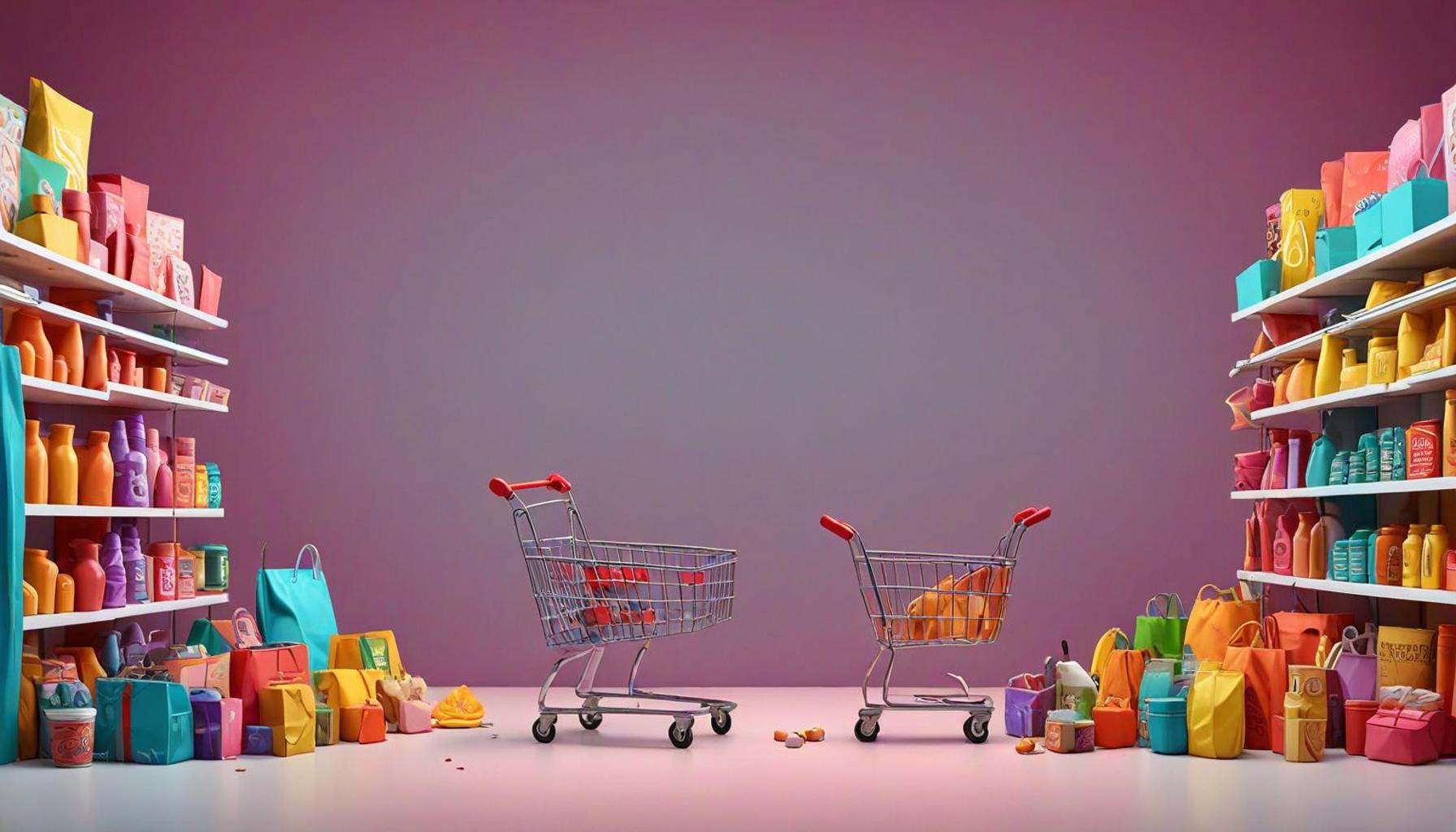The Connection Between Conscious Consumption and Digital Minimalism: Disconnecting to Reduce Clutter

Understanding the Intersection of Lifestyle Choices
In today’s fast-paced world, the need to simplify our lives has never been more urgent. As digital distractions grow, so does the clutter they create—both physically and mentally. This phenomenon leads many to explore the connection between conscious consumption and digital minimalism.
Defining Conscious Consumption
Conscious consumption is about making intentional choices regarding the products we buy. It encourages individuals to pause and evaluate the implications of their purchases, fostering a sense of responsibility towards the environment and society. This approach urges consumers to:
- Evaluate the necessity of each purchase: Before acquiring an item, ask questions like, “Do I truly need this?” or “Will it enhance my life in a meaningful way?” This kind of scrutiny helps reduce impulse buying, which can lead to unnecessary waste.
- Prioritize sustainability and ethical production: Supporting brands that emphasize eco-friendly practices and fair labor conditions not only promotes sustainability but also encourages companies to adopt more responsible practices.
- Foster a mindful approach to spending: Engaging in thoughtful spending can involve budgeting, planning purchases in advance, and recognizing the emotional triggers that lead to buying spurts, which can often mask deeper needs.
Understanding Digital Minimalism
Digital minimalism, on the other hand, is the practice of reducing screen time and digital noise. In a society where technology pervades even the most routine tasks, this lifestyle seeks to reclaim personal time by emphasizing the quality of interactions over the quantity. Essential components of digital minimalism include:
- Limiting social media interactions: By setting strict boundaries on time spent scrolling or engaging online, individuals can reduce mental fatigue and anxiety that often comes from constant comparisons and notifications.
- Curating digital content consumption: Choosing to engage with high-quality content rather than mindless browsing can create a more enriching experience. This might include subscribing to informative newsletters or following educational podcasts, which foster growth and learning.
- Focusing on quality over quantity of information: The digital space is flooded with overwhelming amounts of information. By filtering out the noise and seeking substantial knowledge, individuals can strengthen their understanding of topics that truly matter to them.
Together, these practices can create a significant impact on our mental well-being. By disconnecting from the overwhelming flow of digital information, we can reduce clutter and gain clarity in our lives. For example, several studies have indicated that minimizing distractions leads to improved focus, productivity, and even greater overall happiness. This article will delve deeper into how adopting these principles can lead to a more intentional and simplified existence, inviting readers to reconsider their daily interactions with both the physical and digital worlds. The journey towards simplification and enhanced clarity is not merely about decluttering; it is about developing an enriching lifestyle that resonates with personal values and aspirations.
DIVE DEEPER: Click here to discover practical strategies

Redefining Relationships with Material Goods and Technology
The convergence of conscious consumption and digital minimalism offers an intriguing lens through which to examine how we interact with the world around us. As individuals become more aware of their purchasing habits, they also start to recognize the excesses inherent in their digital lives. This newfound awareness not only promotes a healthier relationship with our material possessions but also empowers us to engage meaningfully with technology.
Seeking Balance in Consumption
The quest for balance begins with reflecting on the meaning and purpose of our purchases. By adopting a straightforward process, we can establish a healthier framework for what we want to buy:
- Identify personal values: Consumers should articulate what truly matters to them—be it sustainability, aesthetics, or functionality. When aligned with personal values, purchases can transcend mere transactions and embody a deeper significance.
- Reduce overconsumption: As part of conscious consumption, individuals can practice an effortless form of moderation. The “one in, one out” rule encourages the disposal or recycling of a similar item for each new acquisition, effectively controlling clutter.
- Engage in intentional shopping: Take time to research products before purchasing. Reading reviews, looking into a brand’s background, and assessing product longevity helps make informed decisions that resonate with one’s conscious mindset.
In the digital realm, similar principles can guide us toward a minimalist lifestyle that fosters mental clarity. The question arises: how do we discern what digital content and tools genuinely serve us without overwhelming our cognitive capacities?
Digital Awareness: Uplifting Quality of Experience
Just as intentional buying can foster a more meaningful interaction with our physical belongings, dismissing digital distractions invites us to curate our online lives with purpose. By focusing on high-quality digital interactions, we can greatly enhance our sense of well-being:
- Prioritize essential tools: Reducing the number of applications, social media channels, or subscription services to those that add authentic value can declutter both our screens and our minds. This curated approach fosters deeper connections with the few digital platforms we choose to engage with.
- Set boundaries with technology: Utilizing strategies like ‘digital detox’ days or scheduled screen time can help mitigate the incessant pull of notifications. Such actions promote a healthier relationship with technology while boosting productivity.
- Embrace offline experiences: Investing time in offline activities—reading physical books, engaging in hobbies, or enjoying nature—can enrich our lives and counteract the impulse to fill free moments with non-essential digital usage.
By understanding the interplay between conscious consumption and digital minimalism, individuals can take tangible steps towards achieving clarity and peace of mind. This journey not only reduces clutter but also invites a profound transformation in how we value both physical goods and digital experiences. As we disconnect from unnecessary distractions, we can redirect our focus to what truly enhances our lives—a guiding principle that resonates deeply in today’s complex digital landscape.
The Benefits of Conscious Consumption
In a world dominated by constant connectivity and consumerism, the practice of conscious consumption plays a pivotal role in enhancing mental clarity and well-being. By being mindful of what we consume, from products to media, individuals can effectively reduce clutter – both physically and digitally. This intentional approach not only highlights the need for quality over quantity but also reinforces the idea that less can indeed be more.
One of the key aspects of conscious consumption is its ability to promote sustainability. By choosing products that are ethically sourced and environmentally friendly, consumers contribute to a more sustainable future. This shift towards sustainability significantly intersects with digital minimalism, as it encourages a streamlined approach to technology and resources, minimizing distractions and unnecessary digital clutter.
The Role of Digital Minimalism
Digital minimalism, on the other hand, focuses on removing the excess from our digital lives. This includes decluttering email inboxes, minimizing social media usage, and eliminating apps that do not provide value. The synergy between conscious consumption and digital minimalism is evident as both philosophies advocate for a life of purpose and intentionality.
As individuals unplug from constant notifications and unnecessary digital distractions, they often find clarity and renewed focus. This disconnection allows for deeper engagement with the world around them, opening up avenues for genuine connections and experiences that purely material consumption cannot offer.
| Advantages | Impact |
|---|---|
| Sustainability | Promotes eco-friendly choices and practices |
| Reduced Stress | Minimizing distractions leads to better mental health |
Ultimately, by embracing both conscious consumption and digital minimalism, individuals can foster a lifestyle that not only reduces clutter but also enhances overall well-being, allowing for more meaningful interactions and a deeper appreciation for what truly matters.
DISCOVER MORE: Click here to learn about mindful consumption
Cultivating Mindfulness in Consumption and Technology Use
The synergy between conscious consumption and digital minimalism extends beyond mere principles; it is about cultivating a lifestyle rooted in mindfulness. As consumers recognize the impact of their choices, they begin to adopt more intentional practices not only in purchasing but also in how they engage with technology. The essence of this transformation lies in fostering a mindset that values quality over quantity across both realms.
Mindful Consumption Practices
Practicing mindfulness in consumption encourages individuals to focus on the long-term implications of their purchases. Beyond just necessary goods, understanding the effects of consumption opens the door to deeper insights:
- Consider the life cycle of products: Awareness of how products are made, used, and disposed of can reshape purchasing decisions. For example, opting for companies that emphasize ethical sourcing or sustainable materials can not only reduce waste but also promote socially responsible behavior.
- Shift towards experiences over things: Research shows that investing in experiences, such as travel or educational workshops, often brings greater satisfaction than accumulating material possessions. This shift encourages a focus on memories and relationships rather than cluttered spaces.
- Support local businesses: Engaging with local suppliers not only fortifies community ties but often results in higher quality products. Supporting businesses that prioritize sustainable practices can help reduce one’s carbon footprint while fostering a local economy.
Digital Mindfulness: Navigating Online Terrain
Similar to mindful consumption, a mindful approach to technology use encourages users to curate their virtual environments thoughtfully. By recognizing the need for balance and mental space, individuals can elevate their digital experiences:
- Consciously curate content: Assess the digital content you consume; prioritize sources that empower personal growth, education, and inspiration. Tools like RSS feeds can help streamline access to quality content, allowing users to bypass aimless scrolling on social media platforms.
- Mindful browsing habits: Designating specific times for checking emails or social media can minimize distractions. Techniques like the Pomodoro Technique, where users focus on a task for twenty-five minutes followed by a five-minute break, can create more productive digital workspaces.
- Limit digital overstimulation: The average American adult spends approximately 11 hours a day consuming media. By intentionally reducing passive media consumption (like binge-watching shows or mindlessly scrolling), users can reclaim time for more fulfilling activities.
Through these mindful practices, both in the physical and digital realms, individuals can cultivate a more intentional lifestyle. The relationship between conscious consumption and digital minimalism fosters an environment where less truly becomes more. By valuing experiences, sustainability, and healthy tech habits, consumers can nurture both their physical spaces and mental well-being. This holistic approach to life enables individuals to navigate a world filled with excess, paving the way for a peaceful existence defined by clarity and purpose.
DISCOVER MORE: Click here to dive deeper
Conclusion: Embracing Clarity through Conscious Choices
The connection between conscious consumption and digital minimalism represents a powerful opportunity for individuals seeking to redefine their relationship with the world around them. As we navigate through a society laden with consumerist pressures and digital distractions, adopting mindful practices can lead to a transformative lifestyle that prioritizes clarity over chaos.
By engaging in conscious consumption, individuals not only recognize the long-term impact of their purchases but also contribute positively to their communities and the environment. Supporting local businesses or choosing sustainable products fosters not only ethical responsibility but also enhances personal satisfaction and well-being. On the digital front, embracing minimalism enables users to make more intentional choices regarding their technology use, creating a harmonious balance between their physical and virtual lives.
As reported by various studies, individuals who actively engage in these practices often report lower stress levels and greater satisfaction in their daily lives. The deliberate choice to limit overstimulation, whether from excessive media consumption or material excess, encourages a more enriching experience. Ultimately, the synergy between conscious consumption and digital minimalism promotes a lifestyle where individuals are empowered to live with intention, cultivate meaningful connections, and foster mental clarity.
In a rapidly changing world, the call to disconnect from clutter—both physical and digital—resonates profoundly. By prioritizing what truly matters, we open ourselves up to a life defined by purpose and fulfillment. The journey toward a more mindful existence not only benefits individuals but sets the stage for a healthier planet and community, inspiring others to embark on their own path towards reclaiming meaning in an age of excess.


